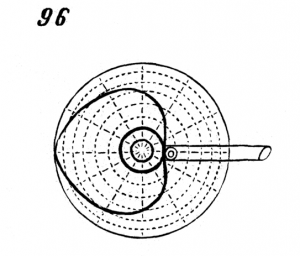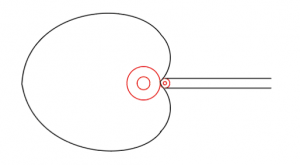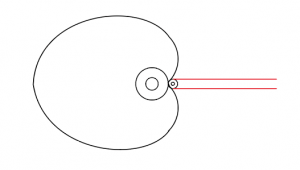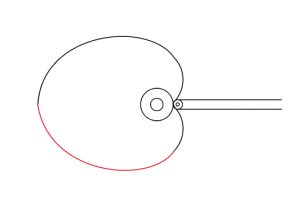Our third assignment in ENGI 210 was to create a 2D drawing of one of the 507 mechanical movements. After scrolling through the many pages of various movement thumbnails, Movement #96 caught my eye… the heart-cam.
The heart-shaped cam rotates around the center axis of the larger wheel component. Simultaneously, the peg and miniature wheel component move along the central horizontal plane away from and toward the center of the mechanism as the heart rotates.
I began my 2D Adobe Illustrator drawing by creating the four circles making up the large and small wheel components. I used the Ellipse Tool while holding down the shift key to created perfect circles. I then used the alignment queues to center and align the respective circle sets.
Next, I used the Line Segment Tool to create the horizontal rod. I simply drew two lines starting from the upper and lower extremities of the smaller circle set and dragged them out horizontally.
Next, I began creating the heart component of the mechanism. I initially used the Arc Tool to create the the shorter, more intense portion of the curve. I aligned one end of the curve in between the circle joints. I used the same tool to create a longer, less-curved arc that I oriented to connect with the smaller arc and to align with the center axis of the mechanism.
I then joined the two separate arcs together by selecting both while holding down the shift key, right clicking, and selecting ‘Join’. After one side was complete, I simple selected the newly joined piece and copied and pasted to create an identical component. I right-clicked on this new, detached segment, selected ‘Transform’, and then reflected the segment horizontally to create a mirror image of the original piece. Lastly, I oriented the top reflection to align with the lower half and the wheel sets. I selected the both sides of the heart and joined them together…
A goal of this project was to accurately represent a movement dimensionally and geometrically. Although my approach was free handed, this particular mechanism relies almost solely on symmetry rather than exact dimensions. As long as the two sides of the heart-cam are identical, the wheels are circular, and the “point” of the heart is not too severe, this mechanism should move no matter the exact dimensions of the heart, rod, or circles.
The heart-cam is a simple design, but a mesmerizing mechanism. Its irregular rotation combined with the horizontal rod tracing the heart is an incredibly calming motion. Hearts represent many wonderful things, including life, love, and happiness. Moreover, because the heart is the key to the 96th mechanical movement, this mechanism is the most beautiful and tranquil of all the 507 movements.
References:





